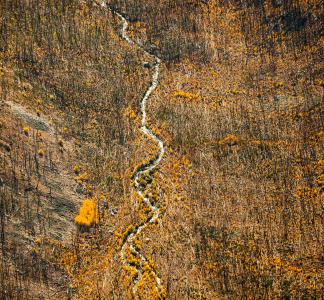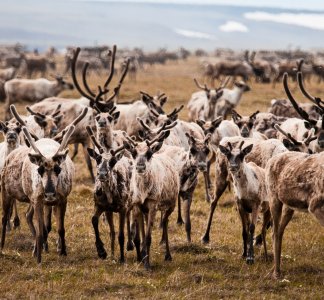Why protecting 30% of lands and waters is critical

Sol Duc River rushing through Olympic National Park, Washington
Chet Williams, Flickr
Ambitious target to help confront climate, extinction crises
On Jan. 27, the U.S. launched an effort to protect 30 percent of U.S. lands and waters by the year 2030. It’s a big, bold goal, fitting our uniquely perilous moment. Experts say protecting an interconnected network of lands and waters will give us the best chance at curbing the worst effects of climate change; adapting to the shifts already happening; preserving wild nature amid an ongoing extinction crisis; and ensuring communities have access to clean air, water and outdoor spaces.
Below are some key facts and figures to help us wrap our minds around the challenges ahead—and also the rare opportunities now facing us.
In the contiguous U.S., more than three-quarters of communities of color live in areas with a higher proportion of natural area lost to human activities than the median level in their respective states. Communities of color are three times more likely than white communities to live in these “nature-deprived" places, resulting from policies and planning that deny decision-making power to Black people, Indigenous people and people of color. Communities of color are also disproportionately exposed to the worst impacts of climate change and pollution. Expanded efforts to protect lands and waters in the U.S. must center equity and ensure communities of color have access to parks and healthy outdoor spaces.
The chart below from the Center for American Progress shows the proportion of people of color in each state who live in nature-deprived areas.
An oft-cited 2019 Center for American Progress report found that the human footprint in the continental U.S. grew by more than 24 million acres from 2001 to 2017—meaning that approximately every 30 seconds, we lost about a football field’s worth of natural areas like forests and wetlands. Those findings expanded on earlier research showing western states lost a total of more than 4,300 square miles to urban sprawl, energy development, transportation, agriculture, timber harvesting and other human activity between 2001 and 2011. We must ensure the 30x30 goal is driven by local needs and nearby communities' preferences for how to stop this loss, and also that it includes plans to invest in communities dependent on energy or other development.
The map below illustrates the growing human-development footprint in the continental U.S. since 2001, showing the trend was most pronounced in the South and Midwest.
A 2018 World Wildlife Fund (WWF) report focusing on how human activity has affected wildlife found that between 1970 and 2014, there was an approximately 60 percent decline in populations of mammals, birds, fish, reptiles and amphibians. The report highlighted deforestation and other types of land degradation as a major driver of this trend, citing data showing only about one-quarter of land on Earth is largely free of human impacts. Protecting 30% of U.S. lands and waters—as part of the global 30x30 goal—is a critical step to shore up critical habitat, save migration corridors and stop the bleeding. For example, species forced to shift to higher elevations in order to escape hotter temperatures need intact, interconnected thruways of land and water to make their move.
The chart below shows The Living Planet Index, an indicator of the state of global biodiversity cited by WWF. It measures the average rate of change over time across a set of species populations and shows an overall decline of 60% in the population sizes of vertebrates between 1970 and 2014--an average drop over half in less than 50 years.
The Trust for Public Land’s ParkScore Index—a measure of how easily residents of major cities can get to parks—reflects the inequity of access to wild nature in the U.S. Of the bottom-25 cities in the most recent ParkScore rankings, 22 have a higher-than-national-average share of people who are Black, Indigenous, Asian, Hispanic, Latino or Pacific Islander, according to U.S. Census Bureau data. On average, those bottom-25 cities are about 64.5% Black, Indigenous, Asian, Hispanic, Latino or Pacific Islander; the top-25 ParkScore cities come in at just 48.8%. As mentioned above, we must protect public lands in such a way that communities of color enjoy access to parks and open spaces that has long been denied them by systemically racist policies and planning.
Zoonotic diseases (those that pass from animals to people) are a major public health concern, as the COVID-19 pandemic amply illustrates.
What does that have to do with protecting public lands? Scientists have suggested that ambitious land-protection efforts could help limit the chances of such outbreaks worldwide (as development pushes deeper into formerly “wild” areas, people are exposed to more new disease vectors; preserving intact habitat undamaged by human development would reduce those instances). Experts have also pointed out that climate change could influence the spread of diseases like COVID-19--as species move around to adapt to climate shifts, they may encounter animals they normally would not, paving the way for pathogens to jump to new hosts. Preserving intact habitat could help on that count as well.
A study published in 2015 in the journal Science Advances found that average rate of vertebrate species loss over the last century is up to 100 times higher than the usual rate, affirming that a “sixth mass extinction” is occurring. The number of wildlife species humans have pushed to extinction in the last century would have taken between 800 and 10,000 years to disappear under normal historical conditions.
The graph below illustrates how many species have been recorded as extinct over time compared to the “background” or ordinary rate of extinction, as represented by the dotted line.
According to an assessment by the Intergovernmental Science-Policy Platform on Biodiversity and Ecosystem Services, about 1 million species are currently threatened with extinction, many within decades. The report also found that 75% of land environments and 66% of marine environments worldwide have been “severely altered” by human actions. In the U.S. 12,000 animal and plant species have been identified by the National Wildlife Federation as needing significant conservation action to get off the path to extinction.
A 2016 study found that we’ve lost about 3.3 million square kilometers of wilderness worldwide in the last 20 years—close to 1.3 million square miles, roughly the total area of India. If those trends continue, “there could be no globally significant wilderness areas left in less than a century.”
The graphic below illustrates extensive losses of wilderness that have occurred in the last two decades worldwide.
According to the UN Office for Disaster Risk Reduction (UNISDR), flooding affected around 2.3 billion people from 1995-2015. Intact ecosystems can help dampen the affect (pardon the expression) of climate change-driven extreme weather on vulnerable communities. For example, restoring and preserving mangrove forests or salt marshes can be an effective means of protecting coastal communities from high storm-surge and flooding.
Scientists say that an ambitious suite of land and ocean protections can help stop the average global temperature from rising more than an additional 1.5 ºC, a key threshold. Such plans would include conservation and restoration of old-growth forest and other landscapes that have a high capacity to absorb carbon emissions.
Tongass National Forest, Alaska
Alan Wu, Flickr
In a study of global biodiversity data published in 2016, scientists found that there were 10.6% more species in protected areas than unprotected areas. Simple: when we make sure to keep key lands and waters healthy and intact, wild things thrive.
Protected public lands like national parks, forests, and wildlife refuges as well as Tribal, state or private lands that enjoy permanent protection in line with the 30x30 goals, total about 14% of the U.S (plus 26% of the ocean). These include areas protecting biodiversity hotspots, like Golden Gate National Recreation Area, and landscapes that are important for carbon sequestration, like Georgia’s Okefenokee National Wildlife Refuge. We already have a solid head-start.
The map below from Defenders of Wildlife shows distribution of USGS Gap Analysis Project (GAP) protected areas in the U.S. (GAP 1 and GAP 2 areas are considered to be those managed in ways consistent with the 30x30 goal; for example, wilderness areas, with the highest possible level of federal protection, are solely in GAP 1 areas).
Mapping survey data have found an “extensive overlap” between Indigenous territories and areas that are important to protect for preserving wild nature, curbing greenhouse-gas emissions or linking migration corridors. This underscores that Indigenous peoples play a key role in combating the climate and extinction crises; research suggests lands managed by Indigenous peoples suffer less degradation and disturbance.
While loss of wild nature is a crisis, there is still a lot left to protect in the U.S.--with plenty of breathing room for communities to grow. Even after the loss of some 24 million acres to development between 2001 and 2017, scientists reported in 2019 that about 60% of the continental U.S. is still in a “natural” or wild state.
Weminuche Wilderness, CO
Mason Cummings
Lands managed or protected by Indigenous peoples are also suffering the effects of the extinction crisis at a slower rate than other areas, an important lesson that large-scale conservation efforts must incorporate traditional Indigenous and local community knowledge. Beyond that, the 30x30 effort must uphold tribal sovereignty and incorporate tribal rights to use traditional lands for fishing, hunting, and other purposes.
A 2019 Center for American Progress poll found that 86 percent of voters support a goal of protecting 30 percent of lands and waters by 2030, with a majority supporting it strongly. Public lands and conservation have always been popular, and it’s likely there will be robust backing for a community-driven movement to preserve key wild lands and waters as a way to confront the climate and extinction crises.
Similarly, the 2021 Conservation in the West Poll conducted by Colorado College’s State of the Rockies Project found that 77% of voters in the West express support for the 30x30 goal.
A 2020 paper found that 96 percent of inventoried roadless areas—a special protected status for the wildest patches of U.S. national forest lands, where road-construction and other damaging development is prohibited—are “wilder” than the median value for the contiguous U.S. and 21 percent are in the top 10 percent of wildest places in the continental U.S. Only 60 percent of those forests protected by the Roadless Rule in 2001 are still protected by it today; strengthening and solidifying roadless forest protections is a huge opportunity to shore up public lands that serve as our invaluable partners, whether by trapping climate-warming greenhouse gas like carbon dioxide from the atmosphere, ensuring clean drinking water or preserving intact habitat and migration corridors for species struggling to adapt to the pressures of climate change.
